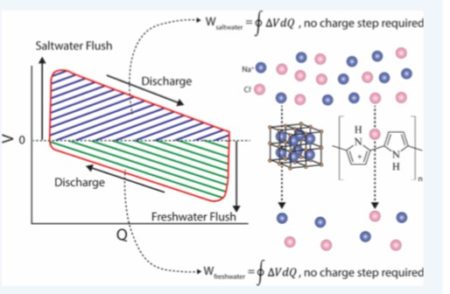July 31, 2019 – University of Stanford researchers in civil and environmental engineering have developed an energy storage battery which they claim could become a reliable source of renewable power. They call the technology “blue energy.”
A downloadable paper describing their discovery, published July 8, 2019, by the American Chemical Society, and entitled “Charge-free Mixing Entropy Battery Enabled by Low-Cost Electrode Materials,” describes the availability of “salinity gradient energy” in estuaries where fresh and seawater mix, estimating the potential “blue energy” yield at 2 Terawatts. It acknowledges that tapping this energy would be challenging, but a feasible starting point would be to use the technology in association with wastewater treatment plants discharging into saline environments. Coastal wastewater treatment plans could, it states be “a significant untapped source of energy” representing 0.65 Kilowatt hours per cubic meter of treated wastewater. The paper proposed that the estimated recoverable energy from wastewater treatment plants globally would amount to 18 Gigawatts. At the least the blue energy yield from a coastal wastewater treatment plant would be more than enough to provide the facility’s energy needs.
How does “blue energy” work?
It uses the natural electrochemistry that exists between saltwater and freshwater when they interact. The higher salt concentrate in the seawater causes molecules from the freshwater to interact creating pressure that can be turned into electricity.
Introducing the MEB
Called a mixing entropy battery or MEB, it uses low-cost, commonly available battery electrode materials to convert salinity gradient energy into high-voltage electricity in a four-step process:
- freshwater exchange
- charing in freshwater
- seawater exchange
- discharging in seawater
Recoverable energy from wastewater effluent is rated at 89.5%, and from seawater, 97.6%. Capacity retention after 50 to 150 cycles of operation, based on the electrode materials chosen varied from 93 to 99%.

States Kristian Dubrawski, a post-doctoral scholar in civil and environmental engineering at Stanford, and a co-author of the paper, “Blue energy is an immense and untapped source of renewable energy… Our battery is a major step toward practically capturing that energy without membranes, moving parts or energy input.”
The significance of MEB is the technology can work anywhere fresh and saltwater mix. But using it in coastal wastewater treatment plants as a renewable energy source makes sense because these facilities are energy-intensive drawing up to 3% of the U.S. total grid capacity.
Theoretically, if MEBs were to be deployed a cubic meter of freshwater when mixed with seawater would produce enough energy to power the typical American home for 30 minutes. If brought to scale, the technology’s potential is mind-blowing.
The technology doesn’t require any expensive materials. There are no moving parts. It doesn’t need expensive membranes or instrumentation to control the charge and voltage. The electrode materials cost between $1 and $3 per kilogram. It can be scaled to not only provide the energy for wastewater treatment, but in places like California and Florida, could produce enough surplus energy to power nearby desalination plants.
Dubrawski calls the invention, “a scientifically elegant solution to a complex problem.” And although it doesn’t address blue energy on a global scale, “it is a good starting point that could spur these advances” turning every river that empties into the ocean at its mouth into an enormous power source using MEB technology.










[…] in 2019, University of Stanford researchers published a paper describing what they called “blue energy.” It proposed a mixing entropy battery or MEB […]